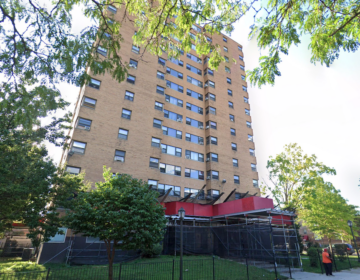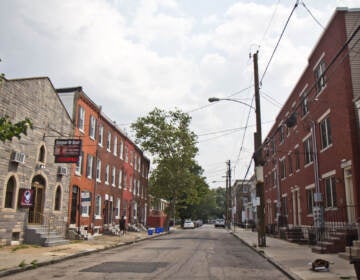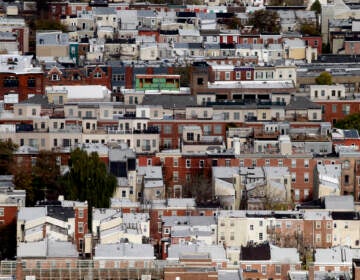For sale: 2 of Philadelphia Housing Authority’s last towers
The new owner will be free to redevelop the buildings and surrounding land as they choose, with no restrictions barring market-rate housing.
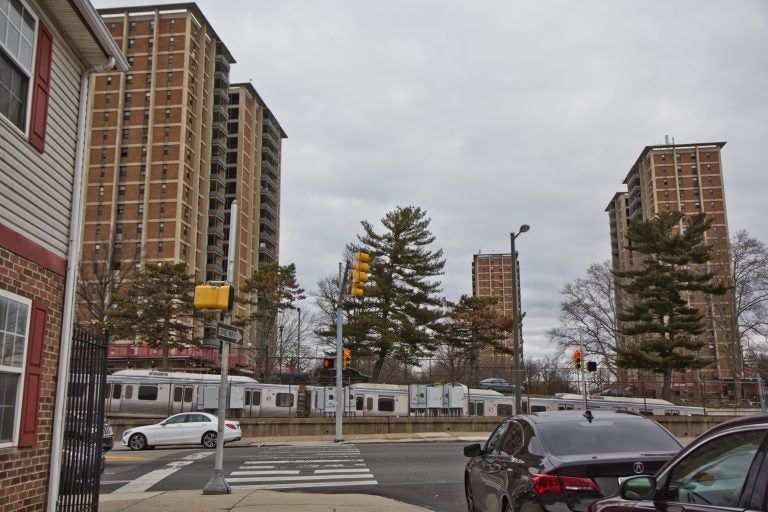
The West Park apartment towers. (Kimberly Paynter/WHYY)
Yvonne Gibbs’ home of almost 50 years is about to change radically.
The Philadelphia Housing Authority’s West Park Apartments are for sale. The agency is seeking a new owner for two of the colossal brick apartment towers north of 46th and Market streets. The third high-rise tower on the site’s western edge will be preserved as senior housing, according to Philadelphia Housing Authority.
“You can see [the whole city] at night time,” said Gibbs, as she sat on a bench in the temperate sunshine of a winter’s morning. “You can see everything. It’s beautiful, and the farther up that you live, the more you can see.”
Gibbs loves the building where she’s lived and raised her family since the late 1960s, but she knows the towers are in desperate need of renovation. The towers need more than $50 million in repairs — an amount of work that would consume almost all of the housing authority’s annual capital budget.
“They aren’t fixing it up, they aren’t keeping it [up] like they was a long time ago,” said Gibbs. “It is deteriorating, the pipes is no good, and the floods we have in here, Lord Jesus. Everything is getting rusted. My bathroom is just a mess, every time they come to fix the pipes they just have to come back again.”
PHA officials hope that by selling a third of the 12-acre site, the cash-strapped agency can secure the money needed to preserve one of the 109-unit towers that make up the 55-year-old complex.
There is already “tremendous interest” in the property, said Nichole Tillman, a PHA spokesperson.
The period to accept bids began on Monday and will last through the rest of the month, ending on February 28th.
The new owner will be free to redevelop the buildings and surrounding land as they choose, with no restrictions barring market-rate housing. The site was recently rezoned to allow for a dense mix of uses so retail and offices could be built, in addition to new homes that PHA expects will target higher-income households.
“We are looking for the highest and best use, whatever that means to a prospective buyer,” said Kelvin Jeremiah, PHA president and CEO, at an interview at the site. “They would have pretty wide latitude to develop what we sell as they see fit.”
PHA plans to build public townhomes on the land it retains. Displaced residents from the old towers will have first dibs on the new low-rise housing, Jeremiah said.
“I promise that you will come back”
The housing authority’s sweeping plans are fraught with both promise and uncertainty for this mini-neighborhood wedged in at the edge of a rapidly changing University City. Many of the city’s wealthiest and most influential anchor institutions are expanding nearby, including the University of Pennsylvania, Children’s Hospital of Philadelphia and Drexel University.
But West Park sits in a liminal zone, with new development and changing racial demographics to the south in Spruce Hill, and to the east, in Mantua and Powelton Village. The development overlooks athletic fields used by Drexel.
The housing complex stands apart from all the surrounding neighborhoods. The towers jut out of 12 acres of green space and crumbling surface parking lots, completely disconnected from the surrounding street grid. There is only one road in or out. High- speed roadways and institutional buildings enfold the site.
The apartment complex dates back to 1964, part of the last wave of high-rise projects built by PHA when its ‘tower in a park’ design was still the favored model for urban public housing.
But the old-school layout means the housing authority’s site also represents a rarity in this area near a booming section of Philadelphia: a vast tract of undeveloped land.
Jeremiah says that privatizing part of the property can be a win for residents.
“The site is an enclave. It isn’t integrated into the larger community,” said Jeremiah. “You know that it is a public housing site not only because of the type of structure — the high-rise and the brown brick, but because it is not accessible or resident-friendly. This is warehousing the poor.”
While this kind of design long ago fell out of favor with public housing administrators and social scientists, the residents interviewed by WHYY are attached to their community and, especially, its convenient location. West Park abuts the 46th Street stop on the Market-Frankford line, while numerous health care, grocery, and restaurant options are within easy walking distance.
“Everything is right here that you need. We have the subway, the Dunkin Donuts, the churches right there. It’s very convenient,” said Gibbs. “Most of the things around here, we don’t have to walk so far. I don’t know how to drive, so it’s convenient for me.”
Jeremiah says the redevelopment will make the area even more walkable. He envisions reconnecting the development to the street grid with pedestrian-friendly streetscapes that will bind PHA residents and newcomers together with the surrounding neighborhood.
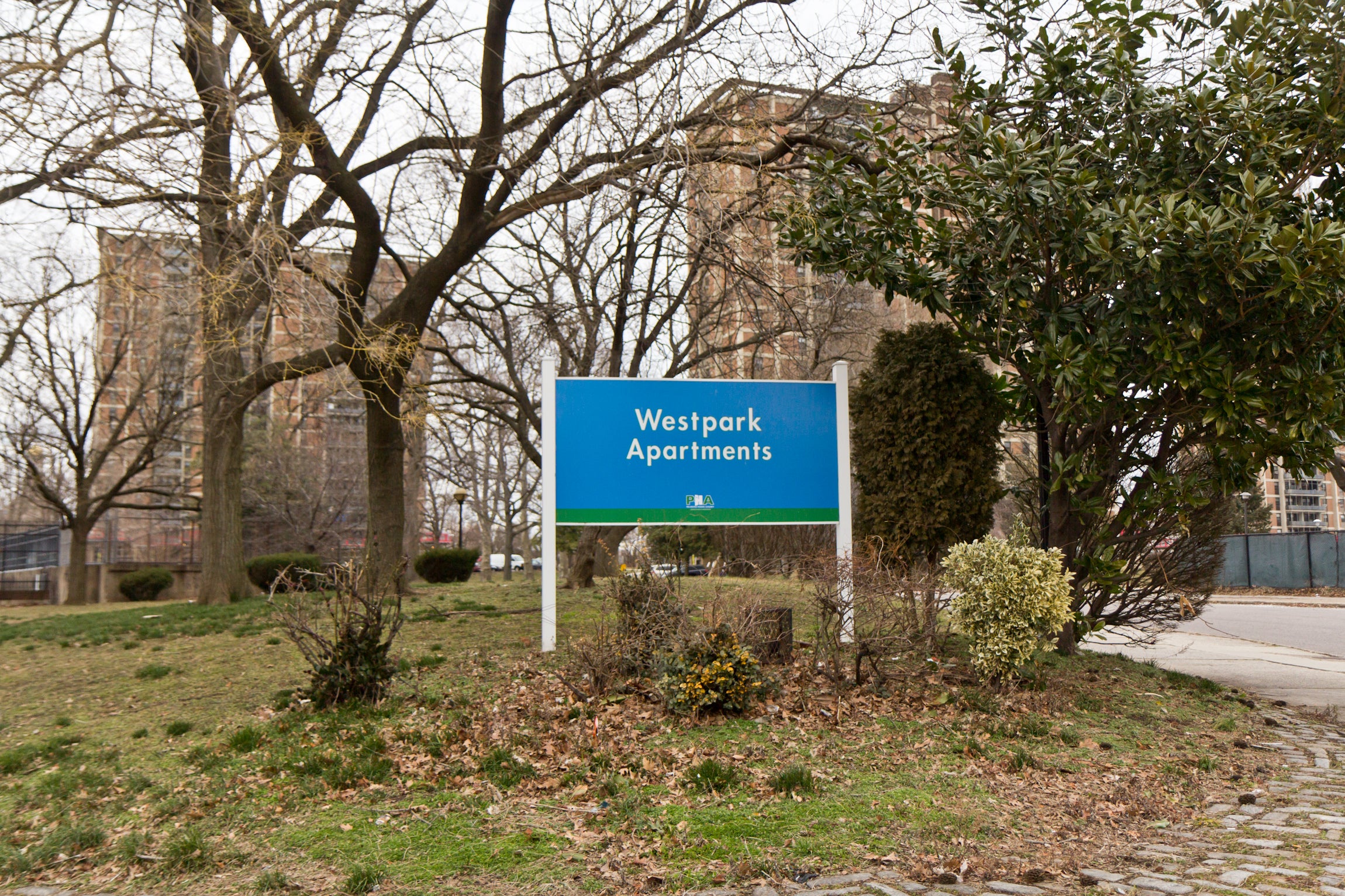
No matter what, Jeremiah says that residents like Gibbs do not have to worry about being permanently exiled from the site. He promises that there will be a one-for-one replacement of the 218 public housing units lost when the two towers are sold.
“As long as I am in my position at PHA, we will never displace our families and we will always maintain affordability in areas that are increasingly becoming unaffordable,” said Jeremiah.
Asked how West Park Apartments can be complexly renovated without displacing residents, Jeremiah said that much would depend on the exact deal worked out with whoever buys the two towers. Families will be relocated within the housing authority’s existing portfolio. His goal is to first rehabilitate the tower for seniors, thus minimizing the disruption for elderly residents in the other two buildings by giving them a place to relocate on site.
PHA has seen a high return rate at developments after renovations, even when the work takes years, Jeremiah said.
“At Blumberg we saw a 98% relocation return rate, at Norris we are seeing about a 60% return rate for seniors,” said Jeremiah. “Seniors offer more challenges. They are at a stage in their life where they don’t like moving. Once they’ve been relocated they don’t like to come back. But overall, I’d say return rates are very, very high.”
But for West Park Council President Andrea Foster, the move is reason enough to be skeptical of the plan, she told both Jeremiah and WHYY.
“As a resident, I have a problem with being relocated to move back into my own home,” said Foster. “But if that’s the way PHA is going to do it, that’s the way PHA is going to do it.”
“I promise that you will come back,” Jeremiah interjected.
Foster has lived in West Park since 1979. She said despite the towers’ disrepair, crime is way down from the 1980s and early 1990s. Seniors and children feel safe playing and relaxing outside, she said.
The resident’s council was consulted about the renovation plan in the lead up to PHA’s announcement last year. Foster embraced the inclusion of a senior tower in the rehabilitation plans.
“Ninety-five percent of seniors don’t want to move from this area,” said Foster. “Their medical, their health, it’s all right here in this area. That’s why we advocated for the senior building.”
Jeremiah said he doesn’t expect any relocation of residents within the next year. The planning effort alone could be another 18 months.
But change, inevitably, will come. Most of the high-rise developments in PHA’s portfolio have already disappeared. Two of the five that remain are slated for redevelopment.
That’s partly because traditional public housing built by the federal government only flourished for a brief period in the mid-20th century. As political support for these programs eroded, government funding for the buildings drooped and then collapsed. Between 2000 and 2015, the federal capital budget for public housing plummeted by 50%.
“For years, Congress has starved local housing authorities of the funds necessary to maintain properties,” said Edward Goetz, a professor of urban planning at the University of Minnesota and author of “New Deal Ruins: Race, Economic Justice and Public Housing Policy.”
“Properties like West Park have fallen into disrepair all over the country and it is common for housing authorities to sell land in order to generate revenue,” said Goetz.
But Jeremiah doesn’t frame plans for the site as a story of the decline of public housing.
“The drivers behind the strategy isn’t PHA management, it isn’t private developers, it is actually the residents of West Park,” said Jeremiah, “who are looking for something different in their site, and who have lived in an antiquated, obsolete, housing development for 50-plus years.”
 WHYY is one of over 20 news organizations producing Broke in Philly, a collaborative reporting project on solutions to poverty and the city’s push towards economic justice. Follow us at @BrokeInPhilly.
WHYY is one of over 20 news organizations producing Broke in Philly, a collaborative reporting project on solutions to poverty and the city’s push towards economic justice. Follow us at @BrokeInPhilly.
WHYY is your source for fact-based, in-depth journalism and information. As a nonprofit organization, we rely on financial support from readers like you. Please give today.




